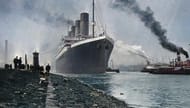
Only 706 of the Titanic's 2,240 passengers and crew members survived, according to History.com.
Due to a number of factors, the number of victims from the sinking is unknown. There were issues with the passenger list, which included some names of people who abruptly canceled their trip, and several passengers traveled under aliases for various reasons, resulting in double counting on the casualty lists. There have been between 1,490 and 1,635 reported fatalities. The Carpathia was able to save some survivors who would have otherwise died from exposure thanks to the use of wireless, even though the Marconi wireless system did not succeed in bringing a rescue ship to the Titanic before it sank.
The area where the Titanic sank had water temperatures that were significantly below average. It also played a part in the quick deaths of many passengers as the ship sank. Water temperatures were reported to be -2 °C (28 °F) at the time of the accident. Mid-April typically sees water temperatures of around 7 °C (45 °F). Many people who were in the water frequently died within minutes as a result of the water's extreme cold. The Titanic disaster was only survived by less than one-third of those on board. A few survivors perished shortly after; several of those brought aboard Carpathia perished as a result of exposure-related illnesses and injuries. The statistics demonstrate the striking differences in the Titanic's various classes' survival rates.
Only 3% of the women in the first class died, but 54% of the third-class women did. In a similar vein, all six children in the first class and five of the six in the second class lived, but 52 of the 79 children in the third class died. More female crew members and first- and second-class passengers were saved than male passengers, making the gender disparities even more pronounced. First-class males died at a higher rate than third-class females. 20% of the men, 75% of the women, and 50% of the children made it out alive.
The last survivor, Millvina Dean of England, who was the youngest passenger on board at just nine weeks old, passed away on May 31, 2009, at the age of 97. The stewardess Violet Jessop and the stoker Arthur John Priest were two special survivors who were on board the RMS Olympic in 1911 when she was rammed and survived the sinkings of both the Titanic and the HMHS Britannic.

Why is the Titanic famous?
The Titanic immediately snatched the public's attention. It was one of the biggest and most luxurious ships in the world at the time. Several compartment doors that could be closed if the bow was breached were another reason it was regarded as unsinkable. But the Titanic struck an iceberg four days into its inaugural voyage in 1912, and it sank in less than three hours.
It became one of the most well-known tragedies in modern history due to the drama of the eyewitness accounts and the significant loss of life. Interest in the Titanic only grew after its wreckage was discovered in 1985, and the enormous success of James Cameron's 1997 movie about the doomed ocean liner demonstrated its enduring appeal.
Was the Titanic covered by insurance?
The hulls and machinery of the Titanic and Olympic were covered by insurance in January 1912, thanks to Lloyd's of London and London Marine Insurance. Each ship received a total of £1,000,000 (equivalent to $102,000,000 today).
The insurers would only cover damage exceeding that amount; the policy was to be "free from all average" under £150,000. Brokers Willis Faber & Company (now Willis Group) negotiated a premium of 15 s (75 p) per £100, or £7,500 (£790,000 today), for a one-year term. Within 30 days, Lloyd's paid the White Star Line the entire amount owed to them.

What financial assistance was given to the Titanic survivors?
Numerous nonprofit organizations were founded to support the survivors and their families, many of whom had lost their only breadwinner or, in the case of many Third Class survivors, everything they owned. For instance, the American Red Cross and the Charity Organization Society formed a joint committee in New York City to distribute financial aid to the surviving family members and dependents of the deceased.
Enrico Caruso, Mary Garden, and other members of the Metropolitan Opera performed renditions of "Autumn" and "Nearer My God To Thee" as part of a special concert on April 29 that raised $12,000 ($300,000 in 2014) for the victims of the disaster. Relief efforts for the families of the Titanic's deceased crew members were organized in Britain, raising nearly £450,000 (equivalent to £47,000,000 today). One of these funds was still active in the 1960s.
More than 60 survivors combined to sue the White Star Line for damages related to loss of life and baggage in the United States and Great Britain. The claims exceeded the amount White Star claimed it was liable for as a limited liability company under American law ($16, 804, 112; roughly $419 million in 2018 USD). White Star petitioned the United States Supreme Court in 1914 because the majority of the parties involved were American citizens. The court ruled in White Star's favor, finding that it met the requirements to be considered an LLC and that negligence was not the primary cause of the ship's sinking.
Because of this, survivors and family members had to limit their claims to about $2.5 million. This significantly reduced the amount of damages they were entitled to.

White Star only agreed to pay $664,000 (roughly $16.56 million in 2018), which is only about 27% of the total sum initially demanded by survivors. 44 claimants agreed to the settlement in December 1915; it included $500,000 for the American claimants, $50,000 for the British claimants, and $114,000 for interest and legal costs.









